What your gastric sleeve scars will look like depends on how your procedure is performed:
- If it’s performed through single-incision laparoscopic surgery you will have one small scar hidden in your belly button. This technique is becoming more common
- If you have multi-port laparoscopic surgery you will be left with 4 to 5 small scars across your abdomen. This technique is still very common
- If open surgery is necessary, you will have a large scar across your abdomen. This technique is usually only done for emergencies that occur during surgery
TABLE OF CONTENTS
Click on any of the topics below to jump directly to that section
- Pictures By Technique
- Minimize Scarring
- Removal
- Internal Gastric Sleeve Scarring
- Find a Weight Loss Surgeon
Read the sections below for everything you need to know about external scars and internal scar tissue after gastric sleeve surgery.
SECTION SUMMARY:
- Single-incision laparoscopic scar (Best - see photo below)
- Multi-port laparoscopic scars (Good - see photo below)
- Open surgery scars (Worst - see photo below)
What does gastric sleeve scar tissue look like?
It depends on which technique your surgeon uses: single-incision laparoscopic, multi-port laparoscopic, or open surgery. Following are descriptions and pictures for each technique, in order of best to worst scarring.
Single-incision Laparoscopic Gastric Sleeve Scar – Best
The “virtually scarless” single-incision laparoscopic technique is quickly gaining popularity, but many surgeons still do not perform it due to not having the proper instruments or training.
Single-incision laparoscopic gastric sleeve scars before and after pictures:
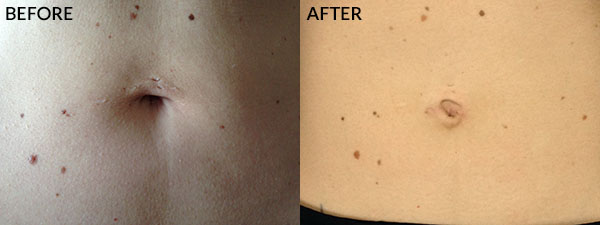
Image source: SurgeryNC.com
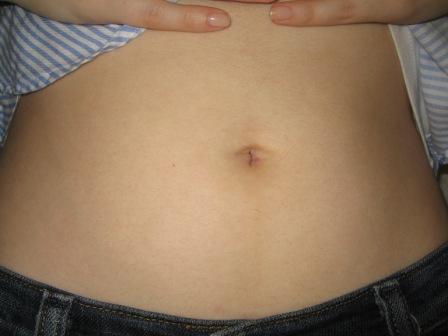
Image source: Advocare
Multi-port Laparoscopic Gastric Sleeve Scars – Good
Less invasive multi-port laparoscopic techniques came into use in the 1990s that insert surgical instruments into 3 to 5 small abdominal incisions across the middle and upper abdomen. This technique is still widely used and is very effective at minimizing gastric sleeve incision scars and the risk of complications.
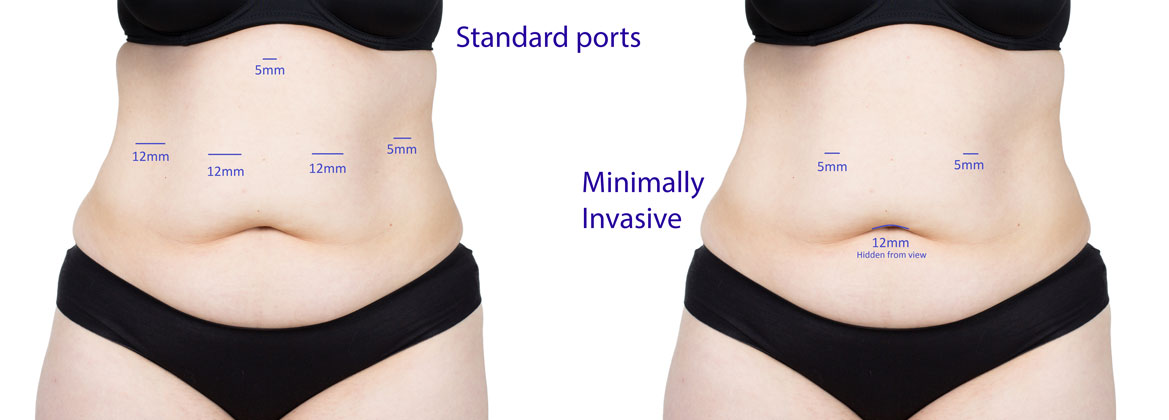
Image source: Anthony Clough General, Upper GI & Bariatric Surgeon
Multi-port laparoscopic gastric sleeve scar pictures:
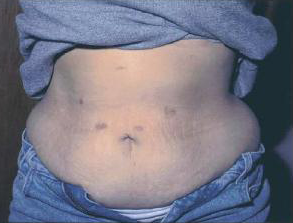
Image source: Cleveland Clinic
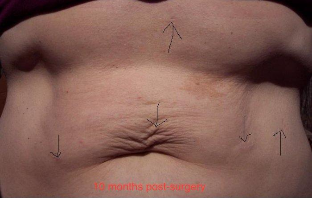
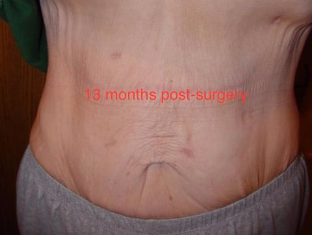
Image source: ObesityHelp
Open Surgery Gastric Sleeve Scars – Worst
When gastric sleeve surgery was first used in 1988, it was accomplished through open surgery requiring a large incision across the abdomen. This left a significant scar and put the patient at a higher risk of complications.
Open surgery is almost never performed anymore, unless there is an emergency.
Open surgery gastric sleeve scar picture:
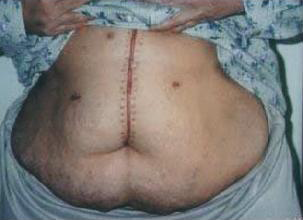
Image source: Cleveland Clinic
SECTION SUMMARY:
- Follow your incision care instructions
- Follow the dietary guidelines
- Follow the exercise recommendations from your doctor
- Don’t smoke
- Avoid alcohol and caffeine
- Get plenty of rest
- Make sure your scar isn't infected
- Avoid having your scars exposed to the sun
There are 4 types of scars from gastric sleeve surgery that you take action to avoid following surgery:
- Hypertrophic scars – Scars that are raised above the level of your skin
- Keloid – Scars that extend beyond the edges of your incisions
- Larger than necessary scars – Result from larger wounds resulting from infection or re-opened incisions
- Discolored and thicker scars – Result from sun exposure
To minimize the risk of these types of gastric sleeve scars from forming:
- Follow your surgeon’s incision care instructions – Keep your incisions clean and covered by:
- Gently washing them with soap and water (no scrubbing or soaking)
- Air dry them or pat dry with a clean towel
- Dress the incisions with sterile bandages/wound dressing
- Don’t pick at your scabs (they will fall off when they’re ready)
- Talk with your surgeon about what you can apply to minimize scarring. Options include silicone sheeting or one of many scar-minimizing creams, lotions, ointments, or natural substances like raw honey or aloe vera.
- Follow your dietitian’s instructions to the letter – Appropriate diet, bariatric vitamins, and liquid intake is crucial towards helping your body to heal itself.
- Follow your surgeon’s exercise recommendations – This will promote blood flow that will help your wounds heal faster which will reduce scarring. However, don’t overdo it, as you do not want to stretch your skin to the point that your incisions pull apart or break open.
- Don’t smoke – Smoking prevents oxygen from getting to your wounds which will make your scars worse. Smoking may even cause your wounds to re-open, leading to even larger scars.
- Don’t drink alcohol and avoid caffeine – They can cause dehydration which will hinder healing.
- Rest – Get plenty of sleep, and don’t overdo your exercise while your incisions are healing. Your body’s healing response performs best when you are fully rested.
- Warning signs – Contact your surgeon immediately if the area around your incisions turns bright red, if your incisions have excessive leaking, or any fluid leaking from your incisions changes color or thickness. These signs may mean there is an infection. If you don’t treat quickly, it is likely that your scars will be worse and that you could face serious medical issues.
- Protect your scars from the sun – by covering them up or by using sunscreen. Overexposure to the sun can cause your scars to change color and cause scar tissue to thicken.
SECTION SUMMARY:
- If your surgeon uses minimally invasive techniques, you likely won't need to treat your scars
- If you want to treat your scars, you can use steroid injections or have plastic surgery
Single-incision laparoscopic procedures are often “invisible”, and most patients find that the small scars left after multi-port laparoscopic gastric sleeve surgery are minor enough to not warrant any special treatment or removal.
If you received an open procedure or have larger-than-normal multi-port scars, you may be a candidate for one of the following scar removal techniques:
- Steroid injections
- Plastic surgery
Neither technique will completely remove the scar, but both can greatly improve your scar’s appearance.
SECTION SUMMARY:
- Abdominal adhesions are bands of scarring that form between your abdominal tissue and your internal organs
- Abdominal adhesions can cause chronic abdominal pain and may lead to bowel obstruction and female infertility
- Abdominal adhesions are much less likely with single-incision or multi-port laparoscopic techniques
During the gastric sleeve procedure, internal organs are moved around. This can lead to internal scarring, also called adhesions, which can cause your organs to stick to each other or to the walls of the abdomen.
The formation of abdominal adhesions is common and, for the most part, doesn’t cause any problems. In some cases, however, they can cause intestinal blockage or bowel obstruction.
Symptoms of internal scar tissue from gastric sleeve surgery include:
- Intermittent bouts of crampy abdominal pain
- Severe abdominal pain
- Nausea
- Vomiting
- Abdominal swelling
- Inability to pass gas
- Constipation
- Signs of dehydration
Patients who experience mild abdominal cramping from time to time can often ease this discomfort by going on a liquid diet for a 24-hour period.
To find out whether you have a bowel obstruction caused by an adhesion, your surgeon will order a CT scan or X-ray of your abdominal cavity. Surgery is the only way to break up the adhesion and fix the blockage.
The best way to avoid abdominal adhesions is by using minimally invasive single-incision or multi-port laparoscopic surgical techniques. They reduce the risk of adhesions by:
- Reducing the risk of blood and blood clotting
- Helping to prevent the organs from drying out by touching the air or surgical gloves
SECTION SUMMARY:
- You can ask a local bariatric practice for a free insurance check or cost quote
- You can attend a free in-person seminar or an online webinar offered by a local weight loss surgeon
- You should schedule a phone or in-person consultation (both often free), if you are interested in learning more about weight loss surgery



